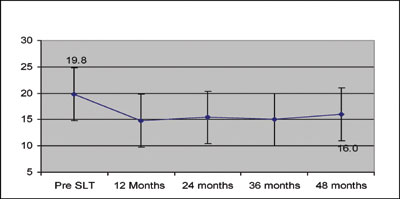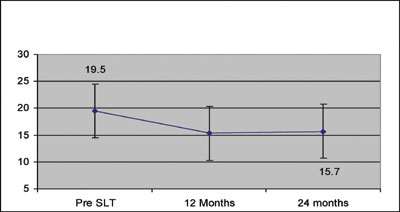SLT can be used to effectively control normal-tension glaucoma
The procedure avoids the side effects that may be associated with topical glaucoma medications.
 Madhu Nagar |
Normal-tension glaucoma is a subtype of open-angle glaucoma in which progressive optic nerve damage and visual field loss occur despite a consistently normal IOP range. Because the IOP is within a normal range and patients are asymptomatic, normal-tension glaucoma is often diagnosed at a much later stage.
Accounting for approximately one-third of all open-angle glaucoma cases, normal-tension glaucoma (NTG) remains an enigma to clinicians and is perceived to occur due to an unusually fragile or sensitive optic nerve, which can be damaged despite normal pressure within the eye. Additionally, reduced blood flow to the optic nerve due to vascular dysregulation (vasospasms and ischemia) may play a role in the pathogenesis of NTG.
Systemic blood pressure control
Greater attention is now being given to the role of systemic blood pressure in the pathogenesis of NTG. Studies using 24-hour blood pressure monitors have demonstrated an increased frequency of nocturnal hypotension in NTG patients. Even as ophthalmologists endorse the use of cardioselective beta-blockers and calcium channel blockers in the treatment of NTG, other researchers recommend topical carbonic anhydrase inhibitors, as they augment perfusion to the axonal bed by inhibiting the vasoconstrictive action of endothelin-1. Investigations also suggest that topical unoprostone may increase tissue blood velocity in the optic nerve head and offer neuroprotection of retinal ganglion cells.
Reducing visual field loss through lowered IOP
The Collaborative Normal-Tension Glaucoma Study reported that visual field loss is greatly reduced by a 30% IOP decrease. While a lower IOP slowed NTG progression in one-sixth of the treated subjects, the disease progressed despite significant IOP reduction. Interestingly, about two-thirds of the untreated group did not experience NTG progression during the first 3 years of follow-up. On the other hand, there is a greater chance of the surgically treated group developing cataracts. It is important to weigh lowering eye pressure with the risk of developing cataracts.
SLT effectiveness
First described by Latina and Park, selective laser trabeculoplasty selectively targets pigmented trabecular meshwork cells without causing coagulative damage. It also minimizes thermal damage to surrounding tissue and postoperative scarring, unlike argon laser trabeculoplasty. SLT uses a Q-switched Nd:YAG laser with a spot size of 400 µm and a 3 ns pulse duration. Various studies have shown SLT to be comparable to latanoprost 0.005% in its efficacy at reducing IOP. Moreover, because damage to the trabecular meshwork is minimal, SLT has the advantage of repeatability.
Retrospective review
To better evaluate the success rate and feasibility of SLT in NTG patients, we performed a retrospective chart review on patients who underwent SLT to treat NTG between January 2000 and December 2005. Seventy-eight eyes of 47 NTG patients received SLT under topical anesthesia with either the frequency-doubled Q-switched Nd:YAG laser Ellex Tango (Ellex Medical Lasers) or the Lumenis Selecta Duet (Lumenis) at the Clayton Eye Centre, Wakefield, U.K., between Jan. 1, 2000, and Dec. 31, 2005. Of these, 45 eyes received SLT as primary treatment and 33 eyes received SLT as secondary treatment.
Data were extracted from patient case notes and recorded in a pre-designed format. The variables of age, sex, diagnosis, visual acuity, pigmentation of angles, degree of angle treated and laser energy used were recorded. Pre-treatment IOP and topical medications used before and after SLT were documented. The IOP was measured using Goldmann applanation tonometry. Combination drops were counted according to the number of active ingredients. For example, Xalacom (Pfizer) contains latanoprost 0.005% and timolol 0.5% and was therefore counted as two medications. IOP after SLT was recorded at 1, 3, 6 and 12 months and yearly thereafter. Success was defined as a 20% drop of IOP from baseline. Nonresponders were patients with IOP reduction of less than 20% within 3 months of treatment.
IOP reduction
The baseline IOP in the 78 NTG eyes at presentation was 19.8 mm Hg. After treatment, the mean IOP was 14.75 mm Hg at 1 year, 15.4 mm Hg at 2 years, 15 mm Hg at 3 years and 16 mm Hg at 4 years. The IOP reductions were 25%, 22%, 24% and 19% at 1, 2, 3 and 4 years, respectively (Figure 1). The frequency of nonresponders was 28%.
 Figure 1. Mean IOP in all 75 eyes receiving SLT for NTG. |
In the 45 eyes in the primary group, the baseline IOP at presentation was 19.5 mm Hg. After treatment, the mean IOP was 15.3 mm Hg at 1 year and 15.7 mm Hg at 2 years. The IOP reductions were 22% and 19% at 1 and 2 years, respectively (Figure 2). Because SLT was not offered as a first-line treatment before 2003, patients in the primary group have been followed up for only 2 years.
 Figure 2. Mean IOP in 45 eyes receiving SLT as primary treatment for NTG. |
In the 33 eyes in the secondary group, the baseline IOP at presentation was 20.3 mm Hg. After treatment, the mean IOP was 15.3 mm Hg at 1 year, 16.3 mm Hg at 2 years, 15.8 mm Hg at 3 years and 15.4 mm Hg at 4 years. The IOP reductions were 25%, 20%, 22% and 24% at 1, 2, 3 and 4 years, respectively (Figure 3).
 Figure 3. Mean IOP in 33 eyes receiving SLT as secondary treatment for NTG. Images: Nagar M |
Consistent IOP reduction
In our study, 25% IOP reduction was achieved in the first year after SLT, which remained stable at around 20% thereafter. These lowered IOP outcomes through SLT are comparable with other glaucoma treatment modalities, such as prostaglandin analogues and carbonic anhydrase inhibitors, without the inherent side effects resulting from medication. In a retrospective cohort study, Ngan and colleagues ascertained that noncompliance was as high as 46% in NTG patients and prevented IOP reduction. Noncompliance can be due to various factors, including costs, the impact of religious instillation of drops on a patient’s lifestyle, physical or mental disability, poor understanding of disease or treatment, and the side effects of medications.
Patient compliance is not a concern with SLT, which is also free from the side effects of topical medication and complications such as cataract associated with trabeculectomy.
In our study we effectively reduced medications by 0.25 per NTG patient while maintaining the 20% IOP reduction.
References:
- Bonomi L, Marchini G, Marraffa M, et al. Prevalence of glaucoma and intraocular pressure distribution in a defined population: the Egna-Neumarkt study. Ophthalmol. 1998;105(2): 209-215.
- Collaborative Normal-Tension Glaucoma Study Group. Comparison of glaucomatous progression between untreated patients with normal-tension glaucoma and patients with therapeutically reduced intraocular pressures. Am J Ophthalmol. 1998;126(4):487-497.
- Eckert S. Effectiveness and relevance of laser trabeculoplasty: treatment of open-angle glaucoma. Ophthalmologe. 2010 Jan;107(1):18-21.
- Hayreh SS, Zimmerman MB, Podhajsky P, Alward WL. Nocturnal arterial hypotension and its role in optic nerve and ocular ischemic disorders. Am J Ophthalmol. 1994;117(5):603-624.
- Kaiser HJ, Flammer J, Graf TH, Stümpfig D. Systemic blood pressure in glaucoma patients. Graefes Arch Clin Exp Ophthalmol. 1993;231(12):677-680.
- Kramer TR, Noecker RJ. Comparison of the morphologic changes after selective laser trabeculoplasty and argon laser trabeculoplasty in human eye bank eyes. Ophthalmol. 2001;108(4):773-779.
- Latina MA, Sibayan SA, Shin DH, Noecker RJ, Marcellino G. Q switched 532 Nd: YAG Laser Trabeculoplasty (Selective Laser Trabeculoplasty): a multicenter, pilot, clinical study. Ophthalmol. 1998;105(11):2082-2090.
- Melamed S. Neuroprotective properties of a synthetic docosanoid, unoprostone isopropyl: clinical benefits in the treatment of glaucoma. Drugs Exp Clin Res. 2002;28(2-3):63-73.
- Nagar M, Ogunyomade A, O’Brart DP, Howes F, Marshall J. A randomised, prospective study comparing selective laser trabeculoplasty with latanoprost for the control of intraocular pressure in ocular hypertension and open angle glaucoma. Br J Ophthalmol. 2005;89(11):1413-1417.
- Ngan R, Lam DL, Mudumbai RC, Chen PP. Risk factors for noncompliance with follow-up among normal-tension glaucoma suspects. Am J Ophthalmol. 2007;144(2):310-311.
- Phelps CD, Corbett JJ. Migraine and low tension glaucoma: a case-control study. Invest Ophthalmol Vis Sci. 1985;26(8):1105-1108.
- Tamaki Y, Araie M, Tomita K, Nagahara M, Sandoh S, Tomidokoro A. Effect of topical unoprostone on circulation of human optic nerve head and retina. J Ocul Pharmacol Ther. 2001;17(6):517-527.
- Madhu Nagar, MBBS, MS Ophth, FRCS Ophth, can be reached at the Clayton Eye Centre, Mid Yorkshire NHS Trust, Northgate, Wakefield WF1 3JS, U.K.; +44-1924-214-173; e-mail: madhunagar@hotmail.com.
- Disclosure: Dr. Nagar has no direct financial interest in the products discussed in this article, nor is she a paid consultant for any companies mentioned.

